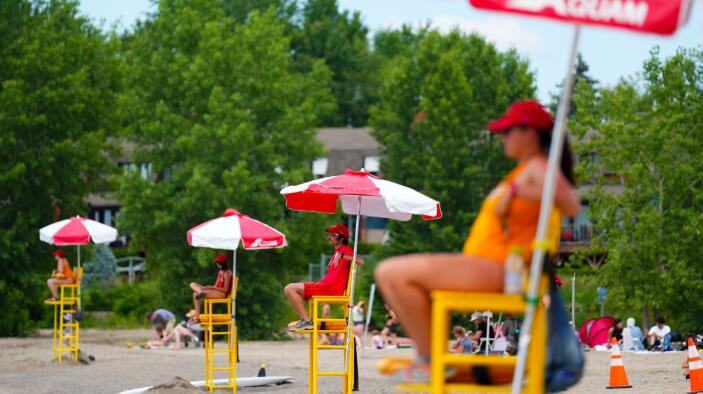How to spot the signs and symptoms of heat illness

Hot and humid summer temperatures are here, and so are the dangers of heat-related illnesses like heat stroke.
“Heat-related illnesses are those illnesses attributable to excess heat on the body causing dysregulation and dysfunction of normal organ systems, and in severe cases, leads to organ failure and death,” Dr. David Ng, an emergency physician in downtown Toronto, told CTVNews.ca. “Severe heat illness leading to organ failure and death is generally uncommon overall, but when it does, it occurs in an epidemic cluster of cases all at once.”
High temperatures killed at least 595 people in B.C. during a 2021 “heat dome,” and another 156 in 2009, according to Health Canada; in Quebec, heat led to 280 deaths in 2010.
Dr. Michael Brauer, a professor at the University of British Columbia’s School of Population and Public Health, says climate change is bringing the threat of heat illness to a growing number of Canadians.
“We’ve always had extreme heat events, but they’re getting warmer and they’re also becoming more frequent,” Dr. Brauer told CTVNews.ca. “This is not going to go away.”
Environment Canada has already issued multiple heat warnings this year, with temperature records being broken in places like Dominion City, Man. and Inuvik, N.W.T. Europe has been even hotter this summer, where the thermometer has neared or passed 40 C in Portugal, Spain, France and even the U.K.
“The warmest part of the summer is yet to come,” Environment Canada senior climatologist Dave Phillips warned on CTV News Channel on Monday. “We think that July and into August will be warmer than normal.”
While temperatures eased in parts of Canada Monday, heat warnings were in effect for large swaths Saskatchewan, Manitoba and Ontario. Environment Canada’s criteria for issuing a heat warning varies by region, but they generally occur when temperatures near 30 C for two or more consecutive days, increasing the risk of heat-related illness.
SIGNS OF HEAT ILLNESS
According to Health Canada, signs of heat illness can include headache, nausea or vomiting, dizziness or fainting, rapid breathing and heartbeat, extreme thirst, or decreased or unusually dark yellow urine. Rashes, confusion, muscle cramps and heavy sweating are also indicators.
“When someone is having heat illness, the body does its best to cool off by sweating,” Dr. Ng explained. “However, sometimes it is too hot to sweat it off. When this happens, a person can transition from heat exhaustion into heat stroke.”
Heat stroke can be lethal or life-altering, and is evident when someone has a high body temperature and is either unconscious, confused or has stopped sweating.
“The symptoms of mild heat illness, such as heat exhaustion, have overlap with severe heat illness in terms of hot skin, dizziness, headache, nausea, vomiting,” Dr. Ng said. “However, once any neurological symptoms occur, such as confusion, irritability, or seizure, this condition becomes heat stroke and this is a life-threatening emergency. Even in those that survive, many can have long term neurological complications including balance, memory issues and dementia.”
WHAT SHOULD YOU DO?
If you experience signs or symptoms like these during extreme heat, move to a cooler or shaded place and drink liquids. Immediately seek emergency medical help if someone shows signs of heat stroke.
“If they are confused, or feel quite sick, it is absolutely essential to call 911 and have them evaluated and treated in an emergency department as organ failure and death can occur in the event of heat stroke,” Dr. Ng warned.
While waiting for assistance, you can cool someone by fanning them and applying cold water to their skin and clothes.
Dr. Brauer also emphasized the importance of checking in on people who are socially isolated during heat events, such as the seniors and people with mental illness.
“As heat-related illness works on a person, your ability to actually make decisions decreases, so you may not even realize, or have the ability to sort of cool yourself,” Dr. Brauer said. “So, it’s really important for people to be checking in on each other.”
WHO IS MOST AT RISK?
Infants, young children and older adults are most at risk for heat-related illness, as are people with chronic issues or illnesses like breathing difficulties, heart conditions, kidney disease or diabetes. Those toiling outdoors like construction and road repair workers, as well as people who exercise in the heat, have a higher risk too. Mobility challenges, certain medications, and being pregnant are also factors.
“Unfortunately, there is also a correlation between increased heat and mental health deterioration leading to increased suicides and increased violence leading to intimate partner violence,” Dr. Ng added.
TIPS TO STAY COOL
To stay cool during searing temperatures, draw your blinds and cover up with light-coloured, lightweight and loose-fitting clothing when venturing outdoors. Other tips are also fairly common-sense: wear a hat and sunscreen, stay hydrated, seek out air conditioning, stick to the shade when possible, cool off with a swim or shower, and save strenuous work or exercise for another day or cooler time. Steering clear of hot and heavy meals can help, and so can avoiding using your oven. Also remember to never leave people or pets in a parked vehicle or in direct sunlight.
When it’s really hot, Dr. Brauer says fans aren’t much use.
“They don’t really cool you down,” he said. “Just sort of blowing that dry air actually in many cases can increase your dehydration. Really, putting cool water on your body is sort of the best thing to do, and as well as drinking cool fluids and drinking a lot of cool water.”
Related News
U.S. Supreme Court upholds ruling ordering Trump administration to fulfil $2B in USAID contracts
Demonstrators hold signs on Feb. 27 in Washington, D.C., to honour former USAID employees terminatedRead more
Quebec, Ontario mayors shut out from White House annual meeting
Montreal Mayor Valérie Plante travelled to Washington D.C. to attend an annual meeting at theRead more
